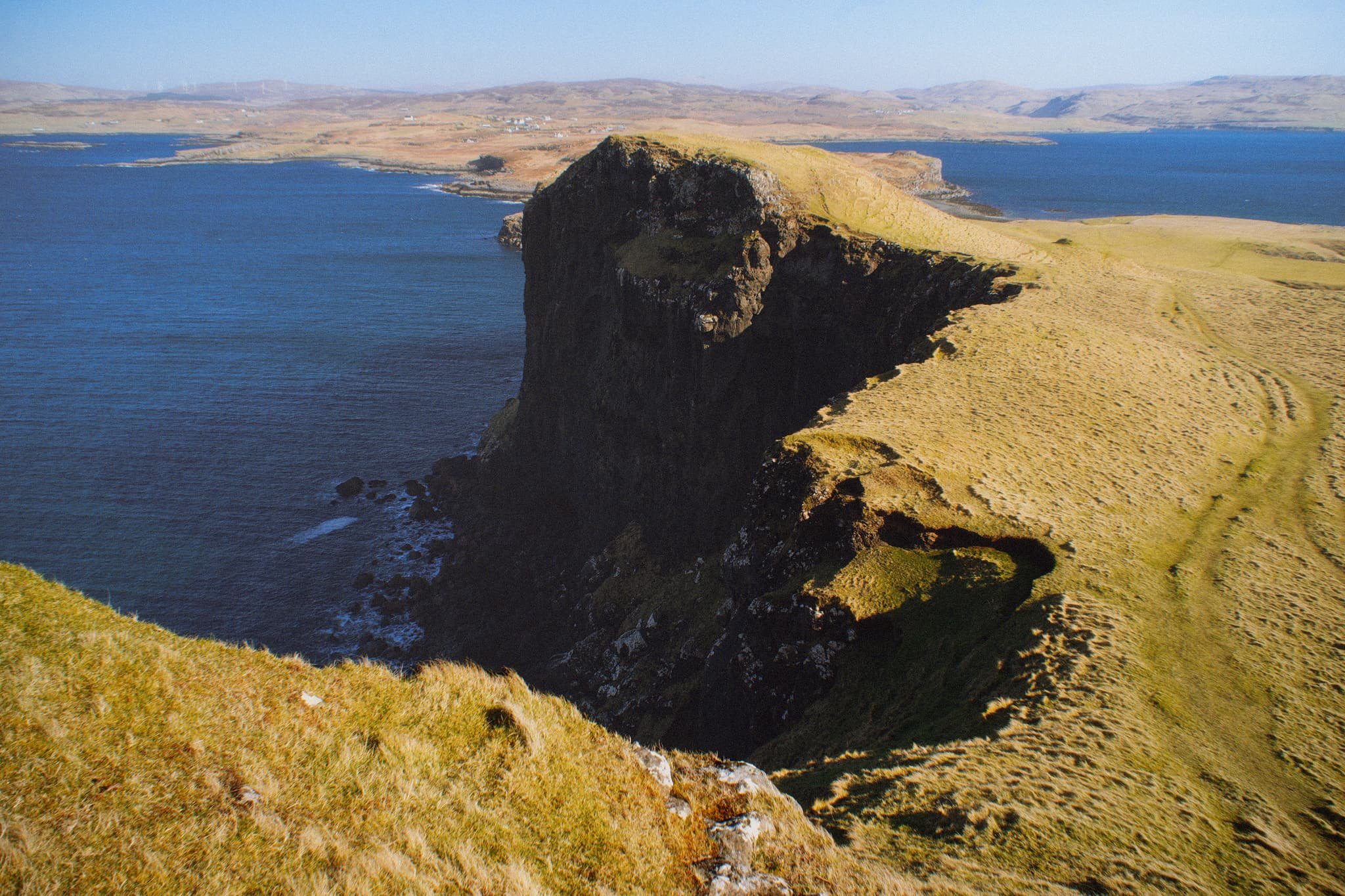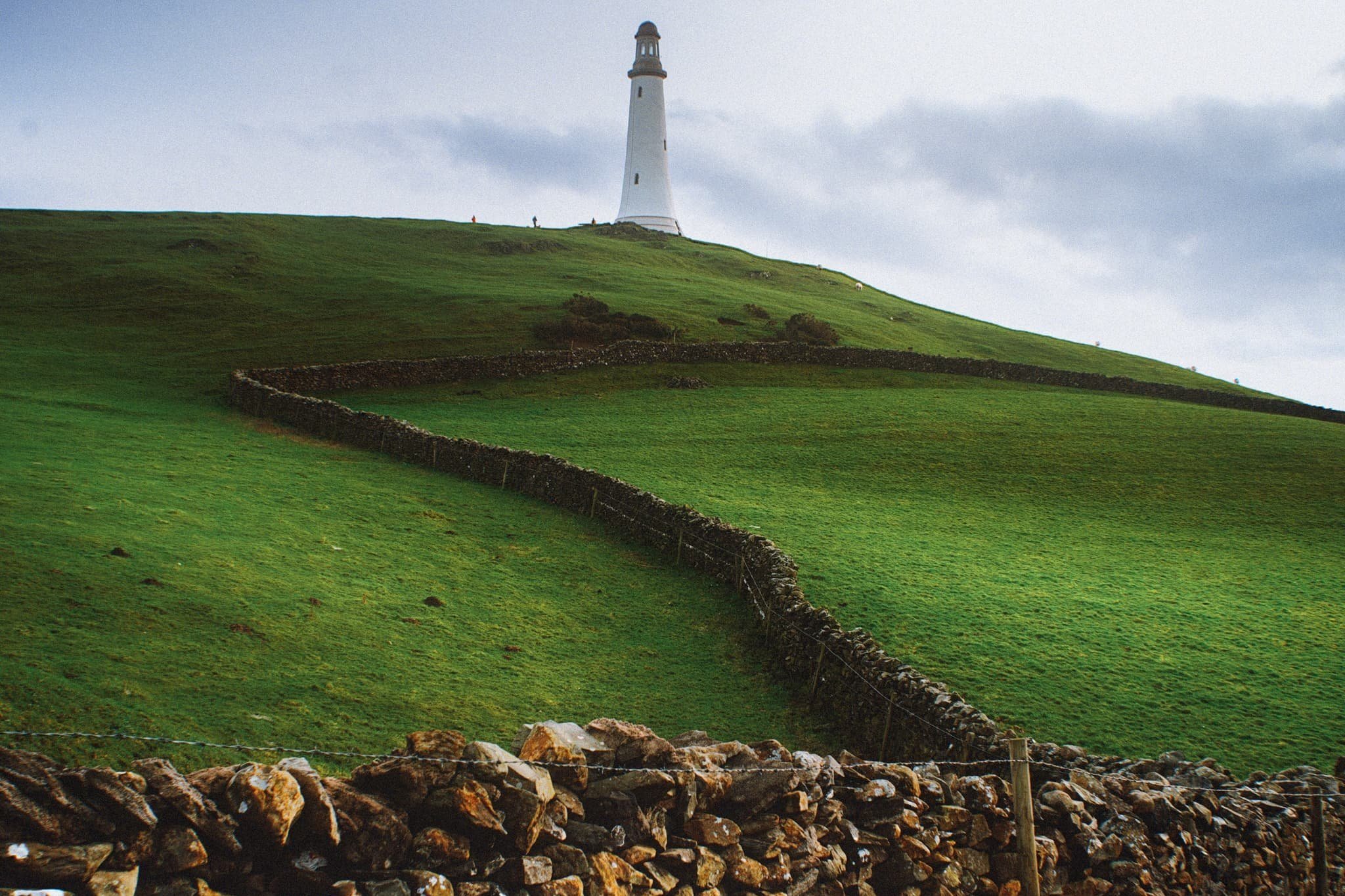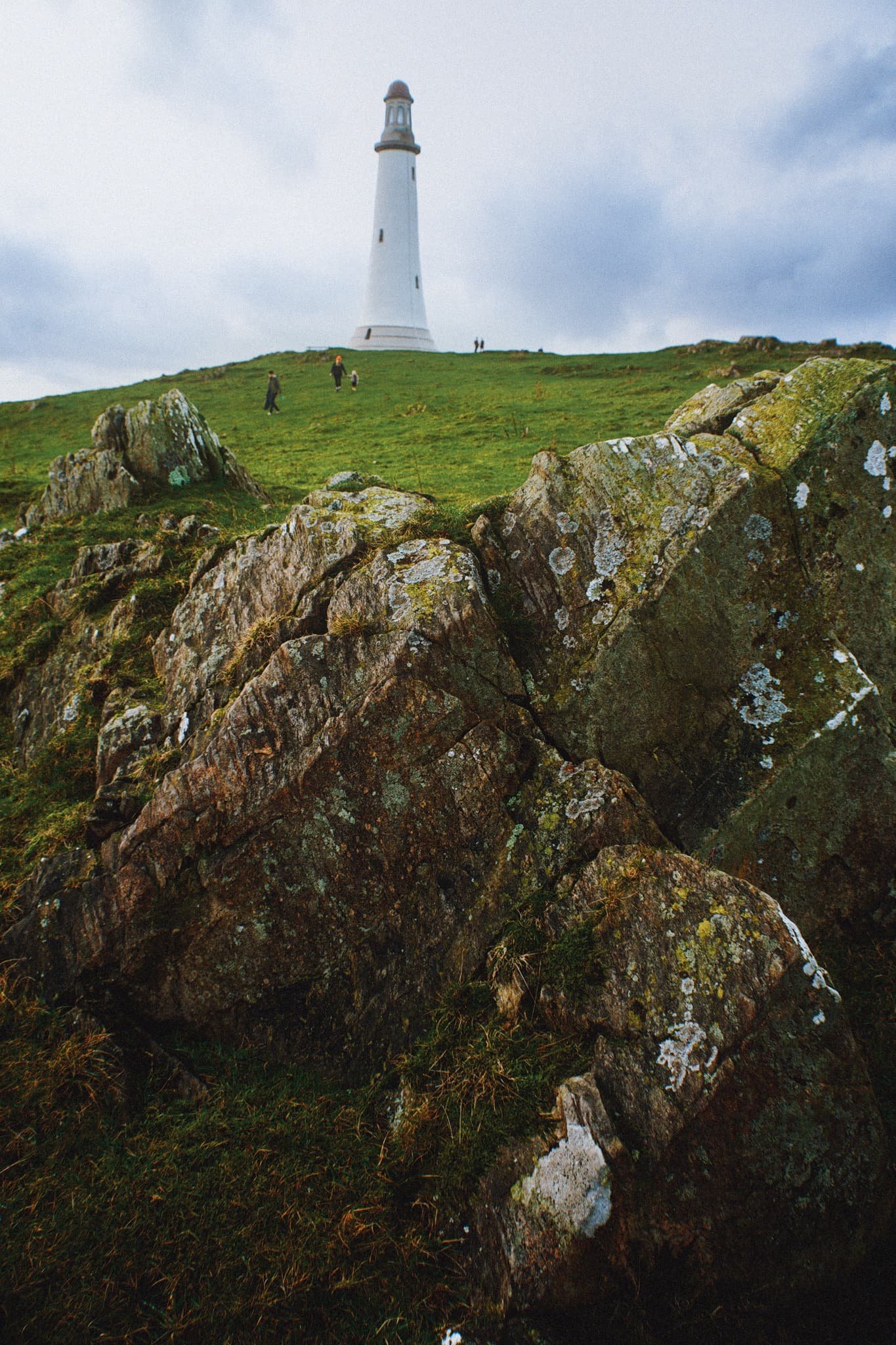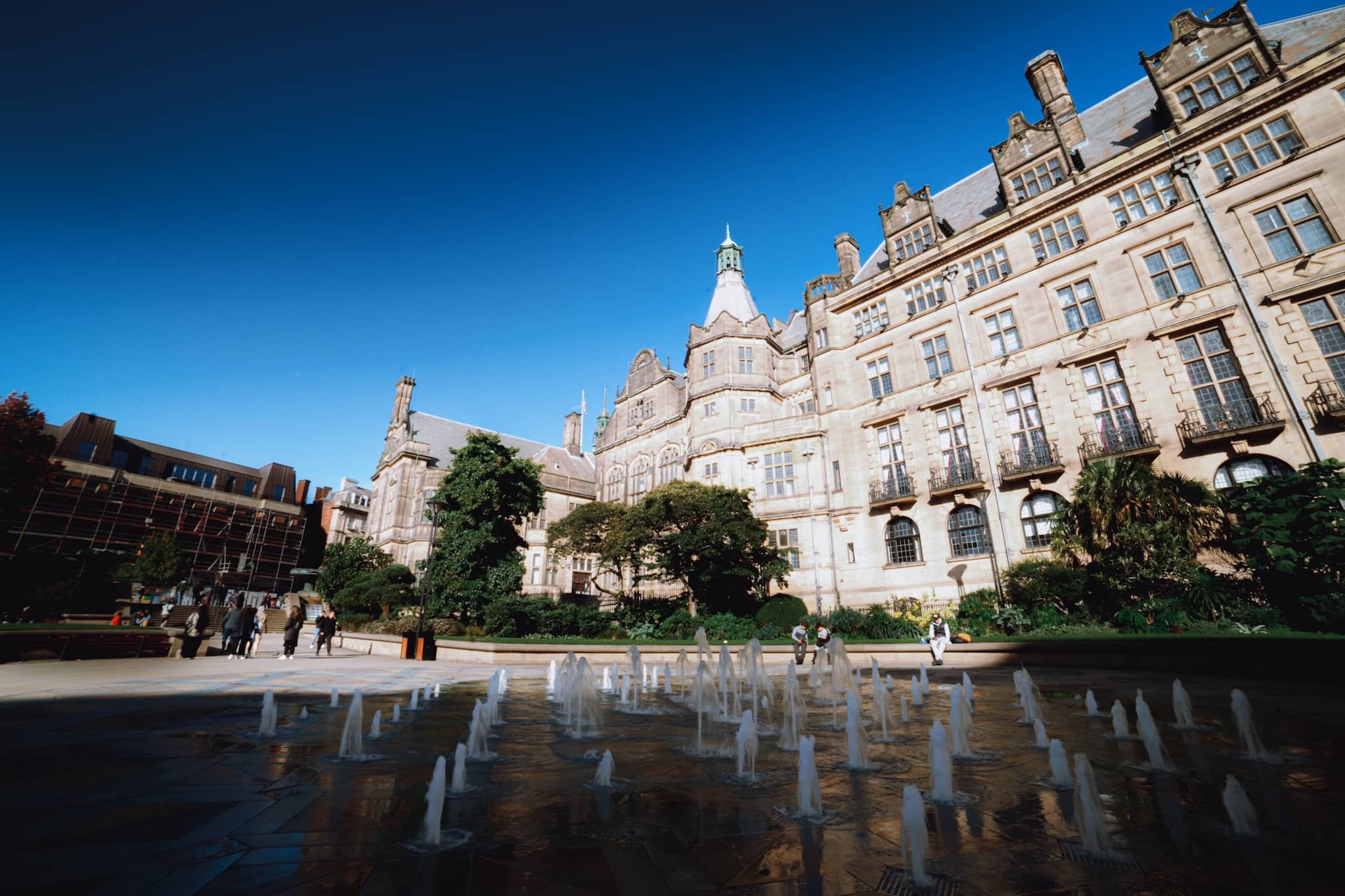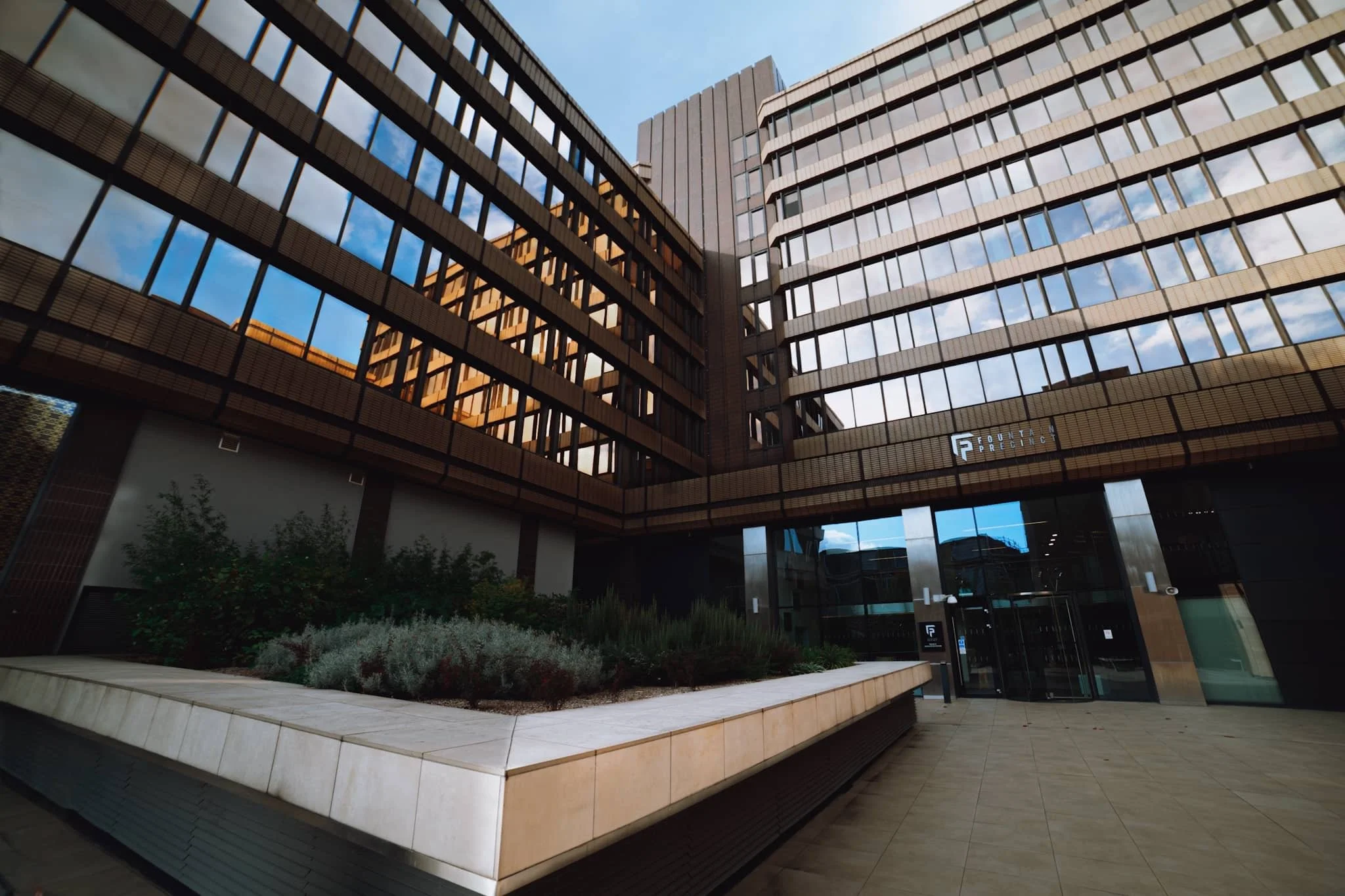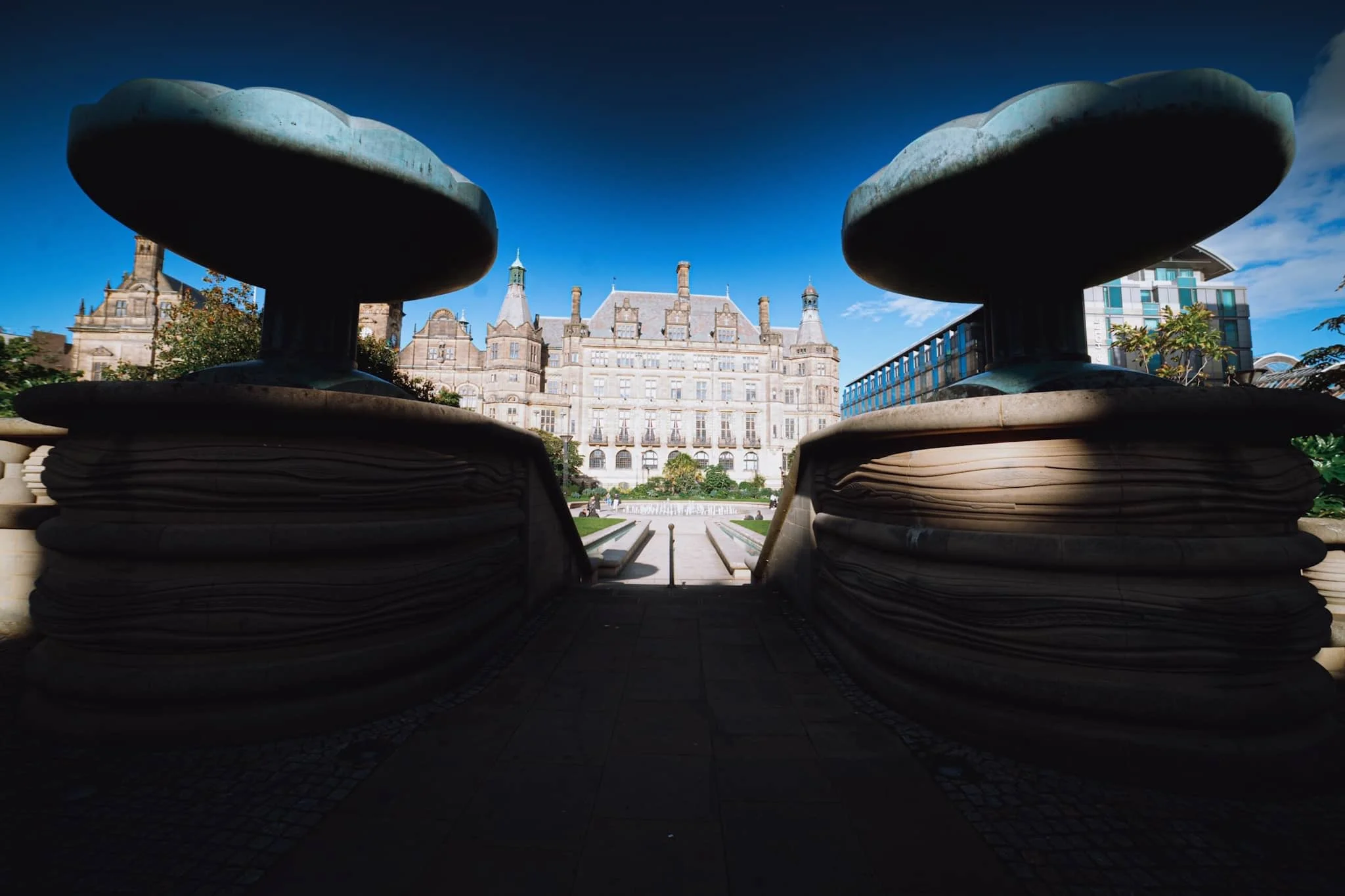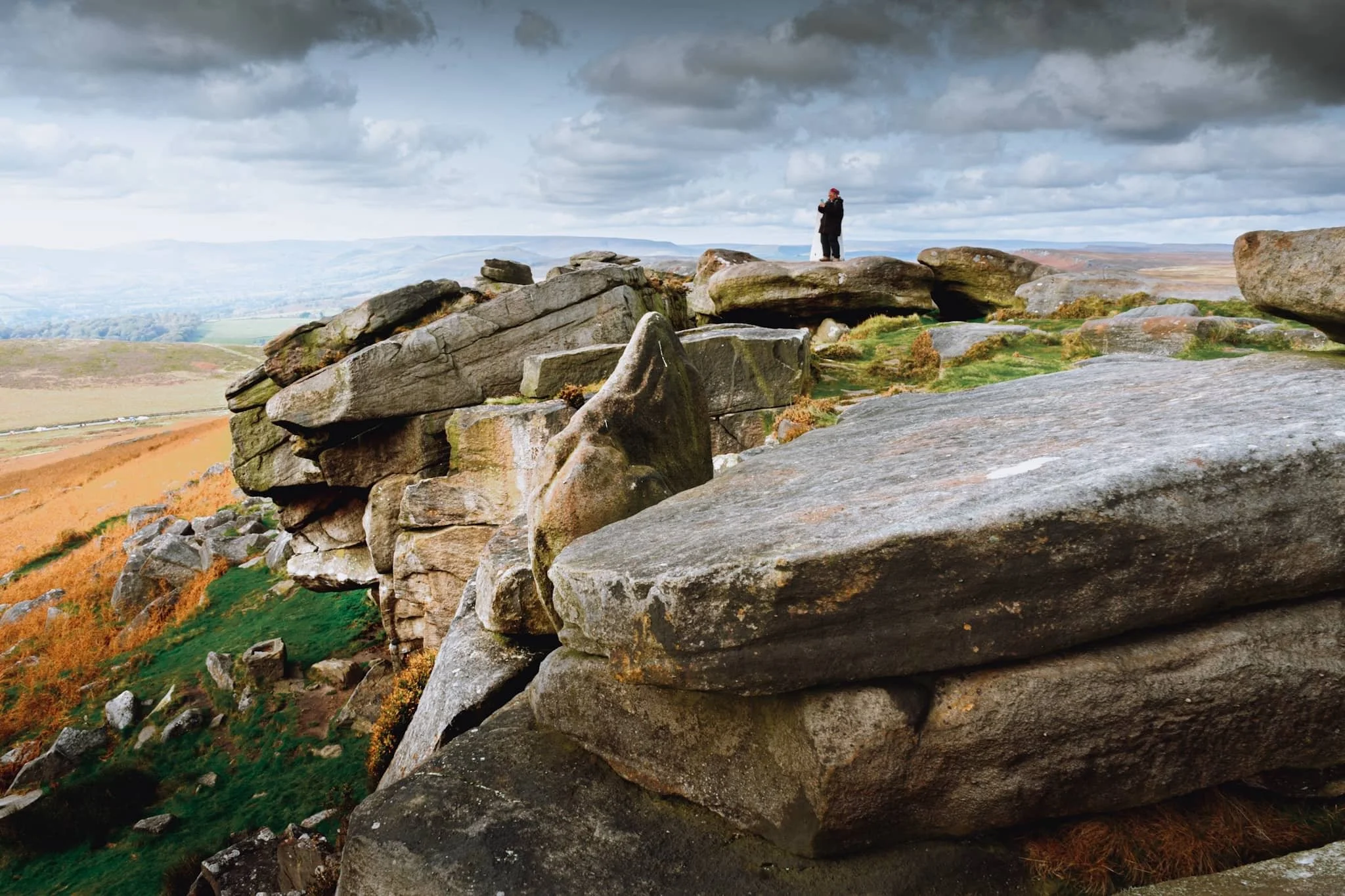Oronsay, Isle of Skye, Scotland, Spring
We’ve only been to the tiny isle of Oronsay once before.
We’ve only been to the tiny isle of Oronsay once before.
This was back in autumn 2020, before the 2nd pandemic lockdown happened.
Conditions on that occasion were cloudy, flat, and grey. But still, the scenery and views were stunning and we vowed to return again.
And so we did, this time with bright spring skies. A world of difference!
Oronsay can be found in Loch Bracadale, along with lots of other little islands, sandwiched in between the Duirinish and Minginish peninsulas. It’s possible to access Oronsay on foot via a tidal causeway consisting of ankle-breaking fist-sized rocks.
Though only 44 acres in size, it features cliffs 240 ft high, which means it offers incredible views to either the cliffs and hills of the Duirinish peninsula, or the cliffs and Cuillins of the Minginish peninsula.
We didn’t see another soul.
All photos taken on my Sony α7ii using my Pentax SMC 28mm F3.5 prime and Vivitar “Series 1” 70–210mm f2.8–4.0 zoom lenses. RAWs developed in Lightroom using RNI Films’ Kodachrome film profiles, edited and finalised in Photoshop.
Oronsay, Isle of Skye, Scotland, Spring by Ian Cylkowski is licensed under CC BY-NC-SA 4.0
From the mainland at Ullinish it’s a simple, if squelchy, walk from the settlement to the coast. The way to Oronsay then becomes clear; at low tide, the sea is parted by a causeway of boulders and rocks.
Once on the island it’s simple enough to navigate your way towards the highest cliffs. Once there, you get stunning views like this. Zoomed in, the island of Wiay is clear and you can even make out the cliffs and sea stacks of MacLeod’s Maidens.
Looking further east, the eastern end of Wiay gives way to the two distinctive flat-topped hills on the Duirinish peninsula, known as MacLeod’s Tables. The one on the left―MacLeod’s Table South or Healabhal Bheag―is 489 m/1,604 ft. The one on the right―MacLeod’s Table North or Healabhal Mhòr―is 469 m/1,538 ft.
From Oronsay’s tallest cliff, the view northeast down the island and across the loch all the way to Skye proper is just stunning.
Looking back at the tallest cliff, it’s contrasty shape and shadow is used to frame the distant island of Wiay and Duirinish cliffs.
My little Lisabet hiking her way up to the next cliff, whilst I shuffled as close as I dared to the precipitous edge for this monstrous view.
A simple leading line of Oronsay’s cliff edges, all the way back to Ullinish and the moorlands of Skye.
Returning to the lowest part of Oronsay, I venture around its more boggy eastern area for a view back to the craggy cliffs, again using the harsh light and shadow to aid in a leading line composition.
Did you enjoy these photos?
Grisedale, Lake District, Winter
Happy New Year, everyone! Here’s to a peaceful and gentler 2024.
Happy New Year, everyone! Here’s to a more peaceful and gentle 2024.
Though I’ve enjoyed time off work between Christmas and New Year, it’s not exactly been pleasant. Storm Gerrit washed across the UK, rendering most days miserably wet. There were even tornado warnings, largely unheard of in the UK.
On New Year’s Eve we learned that New Year’s Day promised much nicer conditions, and so we endeavoured to rise early and head into the Lake District for a solid yomp on the first day of 2024.
Conditions were certainly nicer, though you can never predict weather in the Lake District 100%. Hiking along the valley bottom of Grisedale towards the valley’s head, we were washed with wave after wave of fine drizzle. Thankfully, it never rained that hard, and in between the downpours we still managed to nab some glorious photos.
All photos taken on my Sony α7ii using my Pentax SMC 28mm F3.5 and Pentax SMC 55mm f2.0 prime lenses. RAWs developed in Lightroom using RNI Films’ Kodachrome film profiles, finalised in Photoshop.
Grisedale, Lake District, Winter by Ian Cylkowski is licensed under CC BY-NC-SA 4.0
A sign of things to come. St. Sunday Crag (841 m/2,759 ft), rising above a sodden landscape with stormy clouds above.
Much of the first half of hiking into the valley comprised of dodging waves of drizzle. When one cleared up for long enough, I snuck this shot of Eagle Crag and Dollywaggon Pike (858 m/2,815 ft) battling with the low clouds.
Arriving closer to the turning point, we contemplated the condition of the trail on the other side of the valley. The hike in, on the south of the valley, is thankfully paved but had still been rendered in parts as a beck due to all the rain. I knew that the northern path back down the valley wasn’t in as good nick. So, from here, we turned back the same way we came in.
Thankfully, this was also when conditions started to clear up and the Helvellyn range of fells began to reveal themselves.
Eagle Crag with Nethermostcove Beck roaring down the fellside. A project was started in 2021 to return the valley’s main river, Grisedale Beck, back to its original “wiggly” form. To quote the Friends of the Ullswater Way: “As with many rivers in the UK, Grisedale Beck has historically been straightened and reinforced so that fields can be drained to improve grazing. This work was undertaken over 200 years ago and since then we have learned a lot about how straightened and reinforced rivers can negatively affect wildlife and increase flood risk. It should be noted that, despite the historic changes made to the river at the project site, this is still not particularly good grazing land, being very rough pasture and quite boggy in areas.”
Heading back down the valley, we kept turning back at the beautiful view at the head of Grisedale. Primarily to check on any incoming rain washing over the fells, but also to gawp at them. I enjoyed this composition as the trail seemingly leads across the image towards Nethermostcove Beck on the right. Pure mood.
One of the few pines left in the valley points a vibrant branch towards the beautifully cracked glacial erratic.
As the cloud cover finally starts to lift, Falcon Crag and Tarn Crag emerge from behind Dollywaggon Pike.
Light finally breaks through the clouds as we retreat further down the valley.
The beck streaming down from Blind Cove provides a nice leading line towards the vertical face of St. Sunday Crag.
The fells become obscured again. Another wave of rain heads towards us.
As another squall washes over us, I look across to the northern side of Grisedale and spot these bright becks cascading down the fellside. I very quickly nab a photo.
Soon, we near the foot of the valley and the rains were finally done for the afternoon. Look at that mountain backdrop.
Heading back towards the car, the hulking mound of Place Fell catches the warm winter light across its crags.
We elected for the scenic route back to Kendal, heading north out of Patterdale, through Matterdale, and onto the A65. That way we could turn off to head down St. John’s in the Vale and join the A591 back to Kendal. I kept my camera out, with the 55m attached to it, and grabbed this epic scene of Blencathra from the passenger’s side.
Down St. John’s in the Vale, I kept snapping happily, praying that at least one of the shots rendered sharp. Here, the deep cleft of Beckthorns Gill cuts into various crags of Clough Head.
Further south on the A591, near Thirlmere, Fisherplace Gill cuts a deep fissure within the crags of the Helvellyn massif. The farmhouses below look miniscule in comparison.
The distinctive shape of Browncove Crags, a subsidiary top of Helvellyn, with another deep gill caused by Helvellyn Gill.
Did you enjoy these photos?
Ulverston, Cumbria, Winter
It’s been a while since my last post.
It’s been a while since my last post.
Apologies.
I hope every one has had a nice and/or peaceful Christmas.
Following the arctic blast at the beginning of December, the UK has been wet. Two storms washed over the British Isles—Elin and Fergus—bringing with them intense winds and lots of rain.
Being in Cumbria, we got the bulk of the rain.
Finally, on Boxing Day, clear skies and cool temperatures greeted us. We immediately donned gear and head out to the Furness Peninsula of Cumbria. It was time to hike up the Hoad above Ulverston.
It felt good to finally get out and about.
All photos taken on my Sony α7ii, using my Pentax SMC 28mm F3.5 and Pentax SMC 55mm f2.0 prime lenses, plus my Vivitar “Series 1” 70–210mm f2.8–4.0 zoom lenses. RAW images edited in Lightroom using RNI Films’ Kodachrome film profiles, finalised in Photoshop.
Ulverston, Winter, Cumbria by Ian Cylkowski is licensed under CC BY-NC-SA 4.0
Locating the path from Ford Park, we followed it gently up towards the Hoad. Along the way, this group of trees presented a wonderful framing composition of the Hoad.
The trail quickly grew steeper, which also provided fantastic views. From the shoulder of Hoad Hill, the wet autumn and December are evident in the flooded fields near the coast of the Leven Estuary.
Near the top of the hill, as the trail levelled out, we could start making out the Lakeland fells above the Furness hills. The particularly rounded fell centre-right is Wetherlam (763 m/2,502 ft).
Near the monument, outcrops of Bannisdale Slate gave me a wonderful opportunity for some compositions involving the Hoad.
The Hoad goes by a few names. It’s officially known as the Sir John Barrow Monument, but is also known locally as “the Pepperpot”.
The Hoad was built in 1850 at a cost of £1,250, roughly £138,000 in today’s money. It was built to commemorate Sir John Barrow, who was a founding member of the Royal Geographical Society, and born in Ulverston. Though it looks like a lighthouse, it has never functioned as one.
The views from the Hoad are extensive and panoramic. Plenty of folk were out and about, enjoying a Boxing Day waltz and soaking in the views from the Hoad.
With my 70–210 mm equipped, I was able to pick small sections of Ulverston town. Here, looking southwest from the Hoad, the winding A590 road provides a focal point for the busy architectural landscape of Ulverston.
The view north from the Hoad couldn’t be more different. Rolling countryside, drystone walls, and sheep give way to the mighty Coniston Fells.
Northeast of Hoad Hill, another small hill provides sustenance to yet more sheep. In the distance, the Windermere fells partially obscure the Kentmere fells.
The way back to Ulverston town. You know me, I can’t resist a winding path.
A winding drystone wall catches my eye for a nice composition involving the Hoad.
Back in Ulverston, a wall mural tells the story of Sir John Barrow.
Did you enjoy these photos?
Kendal, Cumbria, Winter
Winter has arrived rather abruptly.
Winter has arrived rather abruptly.
After a week of near- and sub-zero temperatures, the weekend arrived and the snow fell. In Kendal, conditions didn’t seem too bad so we decided to hop int’ car and head into the Lake District proper for some lovely snowy mountain photography.
At Ambleside, we quickly decided we should turn back.
The further we drove into the Lake District, the heavier the snow was. We decided the sensible thing was to turn back and return home. Ultimately, this turned out to be the correct decision. The central and southern Lake District area was buried in snow. 5,000 people have been left without power, and cars have been dumped where they stand, with people seeking temporary shelter.
Today we woke up to a snow covered Kendal. So, we donned our winter gear and some sturdy boots to have a waltz around town whilst we got some errands done.
All photos taken on my Sony α7ii using my Pentax SMC 28mm F3.5 and Pentax SMC 55mm f2.0 prime lenses. RAWs developed in Lightroom using RNI Films’ Kodachrome film profiles. Finalised in Photoshop.
Kendal, Cumbria, Winter by Ian Cylkowski is licensed under CC BY-NC-SA 4.0
My Lisabet, immediately digs in and cleans up for the good of the neighbourhood.
Virgin snow in the courtyard.
Looking back down the cobbled yard to our place. An almost timeless scene.
Families were out in full, making snowmen, throwing snowballs, and sledding on hills.
Abbott Hall, its grounds covered in snow. I love the symmetry of this composition.
The sky attempted to brighten up, but to no avail.
Pleasing shapes and lines created by fresh snow on a winding garden fence.
The picturesque Nether Bridge. I love how timeless this scene is.
Heading back home via Kirkland, the old part of Kendal town. The main road’s been cleared, but I’m sure lots of the minor country roads are still suffering.
Did you enjoy these photos?
Sheffield, South Yorkshire, Autumn
I don’t visit cities enough.
I don’t visit cities enough.
And with staying in the Peak District, we found an opportunity to get on the (extremely busy) train for a day out in Sheffield.
I’d never been to Sheffield before.
What I found was a beautiful city centre, bustling with excitement, development, diverse cultures, delicious food, friendly faces, and wonderful architecture.
I guess it’s probably easy to overlook Sheffield in the face of Manchester or Leeds, but the city had a lot to offer.
And certainly, from a photographic perspective, plenty of fun compositions and buildings to play around with.
All photos taken on my Sony α7ii using my Rokinon 14mm f2.8 ED AS IF UMC ultra-wide angle lenses. RAWs developed and edited in Lightroom for iPad, with a little finalising in Darkroom for iPad.
Sheffield, South Yorkshire, Autumn by Ian Cylkowski is licensed under CC BY-NC-SA 4.0
The first thing that struck us after stepping out of Sheffield Station was Sheaf Square and its wonderful cascades of water. This instantly got me into the “ultra-wide” mindset, and I started snapping compositions.
There was a lot of development happening around Sheffield city centre. This, however, did not detract from the already excellent architecture. These lovely buildings are called the Hubs. Originally built in 2001 to house the National Centre for Popular Music, they were eventually bought by Sheffield Hallam in 2004 and repurposed as the new Hallam Students’ Union building.
This arresting building is, in fact, a car park. Q-Park Charles Street car park was built in 2008, designed by Allies & Morrison, it has “affectionately” been given the nickname “the Cheesegrater”. I think it’s wonderful.
Between Norfolk Street and St. Paul’s Place, this narrow walkway between two buildings allowed a very stark and simple composition towards the Cheesegrater.
Similarly, this composition down St. Paul’s Parade towards the City Lofts also deserved to be captured.
Our first stop of the day were the Peace Gardens. Originally laid out in 1938, they were extensively re-modelled in 1997 to include water features and a central fountain. I immediately zoned in on the fountain, waiting for the water to rise up sufficiently high. I then stopped down to f/22 to get as long an exposure as I could, and framed the impressive 19th century gothic Sheffield Town Hall.
Channels of water line the footpaths around the gardens. They represent the rivers of Sheffield, which were crucial to powering Sheffield’s steel industry in the centuries gone by.
Into the Millennium Square is the entrance to the Sheffield Winter Gardens building. This fabulous piece of architecture features arches of Glulam, that is, Glue Laminated Timber.
The Sheffield Winter Garden is one of the largest temperate glasshouses to be built in the UK in the last 100 years. It’s also the largest urban glasshouse anywhere in Europe.
This place is home to more than 2,000 plants from around the world. Incorporated is the Building Management System, which controls fans and vents to make sure the plants are cooled in summer and kept warm in winter. The system learns year after year.
Our next stop was Sheffield Cathedral. The earliest parts of the cathedral date from the 1200s, with newer constructions (such as on the left in this photo) built in the 1960s.
Entering the cathedral, my attention is drawn upwards to the beautiful abstract pattern in the Lantern Tower. An opportunity to practice composing photos whilst looking straight up.
The nave of the cathedral, probably built in the latter part of the 18th century. A truly grand place.
These 3-metre high wings, Solace Angel Wings, are on display until November 2023. Made up of 100 glass feathers. They serve as a symbol of freedom, unity, and strength. People are encouraged to pose in between the wings, so they too can be angels.
After lunch, we continued wandering around the city centre. Here, Chaps Fountain gave me a lovely image looking towards Sheffield City Hall.
The Fountain Precinct building, built in the 1970s. It primarily offers corporate and office space for businesses. Here, its glass panes caught some beautiful late afternoon light.
Another place we wanted to check out was Sheffield’s Roman Catholic Cathedral, the Cathedral Church of St Marie. It’s home to Sheffield’s tallest spire, at 195 ft tall. When Catholicism was allowed to be openly practised again in England, this building was constructed in the mid-19th century.
Back to the Peace Gardens for one last composition.
Did you enjoy these photos?
Stanage Edge, Peak District, Autumn
Perhaps the Peak District’s most famous edge.
Perhaps the Peak District’s most famous edge.
Froggatt Edge and Curbar Edge were epic enough. But further north, above the bonny village of Hathersage, one can find the massive 3.5-mile long Stanage Edge, which peaks at High Neb 458 m (1,503 ft).
Aside from the height and length of Stanage Edge, and its epic views plus incredible rock formations, the escarpment is famous for rock climbing. Any of the crags and rock walls are not particularly high, perhaps up to 25 m in height, but they are challenging and have been tackled extensively from the mid-20th century onwards.
Thankfully access to Stanage Edge is easy courtesy of numerous small, and free, carparks and road laybys. With the addition of high winds and ever-changing light, we enjoyed an epic hike along this most famous Dark Peak edge.
All photos taken on my Sony α7ii using my Sony FE 28–70mm f3.5–5.6 OSS zoom lens. RAWs developed and edited in Lightroom for iPad, with a little finalising help using Darkroom for iPad.
Stanage Edge, Peak District, Autumn by Ian Cylkowski is licensed under CC BY-NC-SA 4.0
Upon ascending the trail from the off the road, the views immediately open up across the expansive moorland towards Over Owler Tor.
At the trig point 457 m/1,499 ft a. s. l., my Lisabet climbs up to capture those seemingly endless panoramas towards Edale and the Hope Valley.
Smoothed gritstone boulders line the way towards the trig point. Happily, cloud formations above endeavoured to provide another leading line to the trig point.
A drop between two walls provides a nice composition as the light explodes from the clouds, illuminating Over Owler Tor in the distance.
The sun almost completely out, I find a solitary boulder perched precariously on the edge of a gritstone platform.
I crept underneath an overhanging crag that provide me this lovely arrangement of boulders with a view towards Burbage Moor. Fighting the 50+ mph wind gusts, I carefully place the trail below the edge in between the boulders and the crag for a clean leading line.
Further north along Stanage Edge I found a few large gritstone boulders, beautifully smoothed and carved by millennia of erosion. They put me in mind of tortoise shells.
A set of beautifully smooth boulders huddle together against the powerful winds. In the distance, you can just make out Hope Valley with Mam Tor and the Great Ridge rising above.
Lisabet enjoyed making me nervous by standing perilously close to the edge of several severe drops. They did, however, make for excellent photos.
Below Stanage Edge the sharp drop down gives way to miles of fern and bracken, now displaying their rusty autumnal hues as they creep up the escarpment wall.
This was about as close to the edge as I dared, in order to nab a composition with these rock formations, like piles of messily stacked CDs.
Above Hook’s Car, the drop from Stanage Edge is more vertiginous and clearly an area where rock climbers like to upgrade their skills. People to the bottom-left of the image and on top of the edge to the right show the scale of the place.
This was a particularly popular climbing section, with one climber recently ascending to the top of the edge and victoriously pulling up his rope.
From here, it’s actually possible to make out where the White Peak limestone of the Hope Valley gives way to the eastern Dark Peak gritstone.
There were a few of these boulder bridges spanning across gaps that provided lovely little “portal” style compositions to play around with.
Dark Peak landscapes aren’t really known for their caves, like the White Peak is, but there’s a famous one on Stanage Edge: Robin Hood’s Cave, pictured here with people enjoying the shelter and relief from the wind. Did Robin Hood ever rest in this cave? Who knows?
One of my favourite shots from the day, showing the sheer vertical drop down from Stanage Edge, and the full extent of its length into the distance.
Two pillars of gritstone stacks provide another “portal” composition looking across the moorland towards the Peak District’s limestone plateau.
A wider composition, with Stanage Edge continuing on into the distance on the right. In the middle, Bamford Moor gives way to the rolling hills above Derwent Reservoir.
We located one of the main trails down the escarpment and back towards the road. About halfway down, I couldn’t escape this arresting composition. Miles of rusty ferns with Stanage Edge and clouds above.
